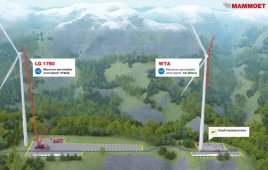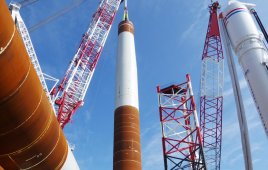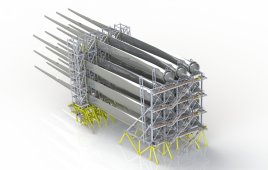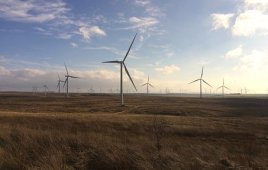This article comes from The Business Network For Offshore Wind
Most coastal U.S. states have progressed beyond debating the merits of offshore wind. Their combined efforts are marching America toward a need for a developed offshore wind supply chain. 2016 is seeing some states progress more than others but the business opportunities remain abundant. Below is a second quarter update on States with offshore activity.
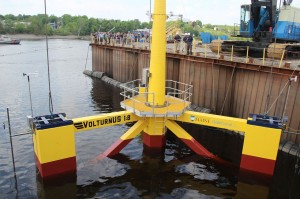
The U.Maine design for a floating turbine platform uses composites instead of steel for floats and an unusual tower to support the turbine. The turbine was launched into the Penobscot River at Cianbro in Brewer Maine.
Maine
The University of Maine’s semi-submersible floating offshore wind design Aqua Ventus received an additional $3.7 million from the U.S. Department of Energy to finalize the design. The UME is also the location of a brand new wind and wave tank for testing many types of naval architecture technologies, including offshore wind designs.
Massachusetts
Activity and interest is underway with the state’s two lease areas; one controlled by Offshore MW LLC (166,886 acres) and the other by DONG Energy, which took over the lease previously held by RES Americas (187,523 acres). RES Americas continues to have involvement in a supporting role to DONG Energy. Geophysical contract work is expected to be announced in the fourth quarter of 2016.
Further, state legislation that would promote offshore wind energy with annual solicitations and associated long-term off-taker contracts is being considered. Massachusetts has the potential to initiate the first state-based offshore wind pipeline. This bill is expected to move forward in July 2016.
Rhode Island
Rhode Island is making history. Deepwater Wind is expected to have the first offshore wind farm with five 6MW wind turbines in state water off Block Island. Project completion is expected this year which will be a landmark for the industry and equally important, an advance in local infrastructure. Block Island will be connected to a new substation, as well as connected to the mainland’s power grid – a first for the U.S. – as Block Island will generate more power than it needs. Cabling is occurring this month (cable laying prep, connection to the inter-ray cables; jet plough to bury the cable 6 feet deep) and should be finished in June or July. The turbines will be installed in July and GE currently has employed more than 100 people to outfit the towers. The nacelles will be transported from France and the project should be commissioned in October.
New York
On April 28th, BOEM held a New York Renewable Energy Task Force meeting in New York to discuss the upcoming lease auction for the Wind Energy Area off Long Island. BOEM stated that it is on an accelerated track and aims to have the auction before the end of 2016. On May 5, BOEM received comments and feedback from the Taskforce and will issue a second RFI to reaffirm developer interest and capture any interest from new developers. This will lead to a Proposed Sales Notice. Offshore wind developers attending the meeting included Deepwater Wind, Dong Energy, Fishermen’s Energy, Magellan Wind, Con Edison Company and Statoil. BOEM expects to hold Environment Assessment public meetings in late June 2016.
As a state with high-energy prices and a large concentration of populations along the coast, New York understands it is prime for a clean energy solution like offshore wind, therefore the State is making the path to offshore wind accessible. The New York State Energy Research and Development Authority (NYSERDA), is expected to submit a blueprint to the NY Department of Public Service that is likely to include a list of reports aimed to help developers ‘de-risk’ OSW projects. The timing of the reports is expected to dovetail with BOEM’s steps leading up to the NY lease. Earlier this year, Governor Andrew Cuomo announced the “New York Offshore Wind Master Plan,” a tactical blueprint outlining the effort to get the state to reach its goal of 50% dependency on renewable energies by 2030. Significant funding to advance the efforts of relevant environmental projects and programs is expected.
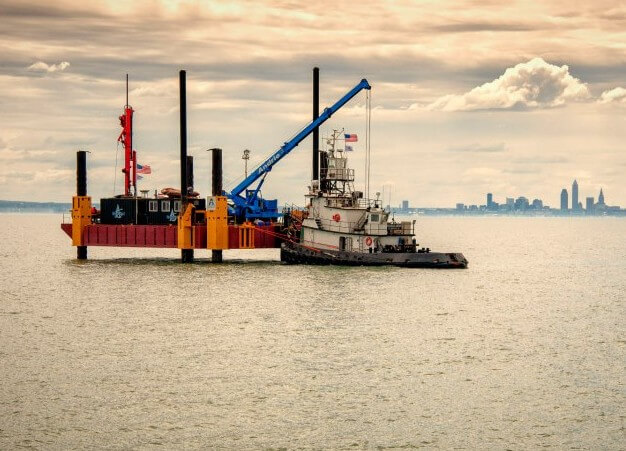
Lake Erie, starting with the Icebreaker project, has tremendous potential of several thousand megawatts.
Ohio
Lake Erie Energy Development Corp. (LEEDCo) continues to support and drive offshore wind in the Great Lakes, primarily in Lake Erie. Norway-based Fred Olsen Renewables has joined a specialized team formed by LEEDCo to develop a foundation and turbine installation strategy that is adapted to the specific environmental and commercial needs of Lake Erie and its freshwater conditions. The wind farm known as “Project Icebreaker,” will connect the Lake Erie wind turbines to the Cleveland power grid. The DOE funded LEEDCo in 2012 with $4 million, and in 2014 provided an additional $3 million for engineering the initial phase of six turbines situated eight miles north of Cleveland in Lake Erie. Lake Erie has tremendous potential of several thousand megawatts.
New Jersey
Last year’s auction for two lease areas in federal water resulted in the south area (160,480 acres) won by RES Americas and the north lease area (183,353 acres) won by U.S. Wind. On May 19th, US BOEM held the New Jersey Intergovernmental Task Force meeting in Trenton, New Jersey. BOEM discussed the overview of commercial leases and next steps. Both US Wind and ResAmericas will make presentations. A public question and answer session will begin shortly after the Task Force meeting adjourns.
Fishermen’s Energy’s 25 MW, five-turbine wind farm continues to move forward despite delays.
Maryland
Developer U.S. Wind, having completed the necessary geophysical and geotechnical surveys in June, 2015, submitted its site assessment plan (SAP) on time to BOEM with operational blueprints expected to follow later this year. U.S. Wind submitted its Offshore Renewable Energy Credit (OREC) application to the Maryland Public Service Commission in late February 201 and is planning to install a fixed-bottom metrological mast by summer 2016.
With the receipt of the initial application for a proposed offshore wind project, the Maryland Public Service Commission has now opened a 180-day application period for any other developers of offshore wind projects off the Maryland coast. This application period begins on February 25, 2016 and, unless extended, ends at the close of business on August 23, 2016. Any party interested in submitting an application for an offshore wind project is encouraged to visit the dedicated website (www.marylandoffshorewind.com) hosted by the Commission’s consultant, Levitan and Associates, Inc. The website includes information necessary to complete the application process, as well as links to questions and answers, applicable regulations, statutes and authorizing legislation.
Virginia
Dominion Power, the developer constructing two turbines with a 6MW capacity 24 nautical miles off Virginia’s coast, re-bid the solicitations for different parts of the Virginia Offshore Wind Technology Advancement Project (VOWTAP). The solicitations were for: a) transportation, erection and installation of the inward battered guide structure foundations and wind turbine generators; b) final design, manufacture, transportation, installation, horizontal directional drilling and termination of the export and inter-array cables; and c) foundation fabrication, onshore interconnection station equipment and installation, along with updated estimates for instrumentation, commissioning, and project management. Dominion has received bids for the VOWTAP project with a total lower cost than the prior response and is in discussion with US DoE on an grant extension. Upon moving forward, Dominon plans to file a letter of intent with the State Corporation Commission (SCC) for regulatory review of the project. As a regulated utility in Virginia, Dominion has to take all projects of this size to the SCC for approval.
North Carolina
Following the completed work for North Carolina’s geological, ecological and ‘conflict-of-use’ investigations, North Carolina was poised to have a significant potential lease area of 195 whole and 60 partial ocean lease blocks. April 2016 witnessed a bold move by BOEM, which may reflect North Carolina’s cautiously slow approach for advancing offshore wind development. The auction process may be delayed as North Carolina’s State Department of Environment and Quality recently cited concern for the coast’s “viewsheds” as well as the potential disruption of the lifecycles of both migratory and stationary animals, BOEM made a bold move to put part of the identified area into the South Carolina lease blocks. South Carolina, once considered to have the largest U.S. area being made available for offshore wind development is likely to have only the 22,400-acre Kitty Hawk area available for its offshore wind development.
South Carolina
BOEM had identified four areas in total for offshore wind areas off South Carolina. U.S. Wind and Fishermen’s Energy put their names next to the Grand Strand zone. Fishermen’s also nominated the Cape Romain, Winyah and Charleston call areas. BOEM is reviewing the developers’ qualifications to determine if it will proceed with a competitive or non-competitive lease process as well as preparing an environmental assessment for the call areas. Interesting new developments include the 51,600-acre Wilmington West and 133,600-acre Wilmington East tracts of the North Carolina offshore wind area, which border the much larger 628,000-acre Grand Strand lease area in South Carolina which have been realigned into South Carolina. On May 17th, the North and South Carolina task forces will merge to take over planning and analysis. Continue to watch this space!
Georgia
Georgia Power applied for three leases offshore to conduct wind viability tests. One area was rejected due to national defense, but two remained. With these, the intention was to measure wind speeds at various altitudes with LIDAR light detection and ranging data. Originally, if data revealed viable wind off the Georgia coast, there were aspirations to add this clean energy generation to its portfolio in the 2020s. These plans continue to have a stalled status.
California
Floating offshore wind technologies are being considered for the deeper waters found in the Pacific Outer Continental Shelf. US BOEM received and reviewed an unsolicited lease request from Trident Winds, LLC for a floating wind energy project offshore from Morro Bay, California, and is expected to shortly issue a Federal Register Notice to determine any competitive interest.
The Trident project could contribute 800 MW of nameplate capacity consisting of ~100 floating foundations, possibly using large 8 MW wind turbines. Further, BOEM is processing an unsolicited lease request for a proposed floating wind demonstration project offshore of Coos Bay, Oregon involving three 6.0 to 8.0 MW floating wind turbine turbines, anchored to the seafloor in 1,200 to 1,600 feet of water.
Oregon
US BOEM is processing an unsolicited lease request for a proposed floating wind demonstration project offshore of Coos Bay, Oregon. The project would consist of up to three 6.0 to 8.0 MW wind turbine generators mounted on floating foundations, anchored to the seafloor in 1,200 to 1,600 feet water depth.
Hawaii
Interests in Hawaii remains strong as BOEM is processing three unsolicited lease requests for offshore wind energy development off the island of Oahu. Two projects are proposed by AW Hawaii Wind, LLC (AWH), while the other is proposed by Progression Hawaii Offshore Wind, Inc. (Progression). Each of the proposed projects would yield approximately 400MW from wind turbines on floating platforms in water depths ranging from approximately 950 to 3,200 feet. The fourth task force meeting in Hawaii was scheduled for May 16, 2016. (More infor here). Hawaii is expected to accelerate its involvement with offshore wind with announcements as soon as this summer.
Filed Under: Construction, Offshore wind

